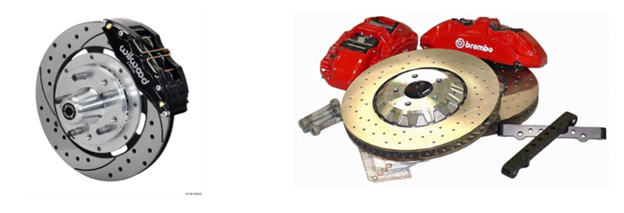Sign up now to join the JEGS email newsletter and be the first to learn about new products, special deals and e-mail only offers!

If you’re the proud owner of a high-performance vehicle, you already know the importance of maintaining every aspect of your car to ensure it performs at its best. Nothing is more important than your vehicle’s braking system. Properly lubricating your brakes can make a significant difference in your vehicle’s overall performance and safety.
In this guide, we will delve into brake lubrication, including why it’s essential, signs your brakes need lubrication, and step-by-step instructions on how to lubricate brakes effectively, including where to grease brake pads. We’ll also cover where and where not to apply brake lube and introduce you to Powerstop Performance Brakes, a top-tier brake solution for high-performance vehicles.
Brakes are one of the most crucial safety features of any vehicle, and in the realm of high-performance cars, they are even more critical. Proper brake maintenance can be the difference between a thrilling driving experience and a dangerous one. Here’s why it’s essential to lubricate your brakes:
Lubricating your brakes helps prevent that annoying squeaking or squealing sound you might have encountered when coming to a stop. This noise is often caused by friction and vibrations between the brake components. Brake lubricant acts as an insulator, reducing friction and noise.
When your brakes are well-lubricated, they can operate smoothly and efficiently. This means quicker response times and improved overall braking performance, especially in high-performance vehicles where precision matters most.
Lubrication not only reduces wear and tear on the brake components but also prolongs the life of your brake pads. This translates to cost savings in the long run, as you won’t need to replace your brake pads as frequently.
Brake components are exposed to harsh conditions, including heat, moisture, and road debris. Brake lubricant helps form a protective barrier against corrosion, ensuring your brake system’s longevity.
Before you start applying brake lubricant, you should be able to recognize the signs that your brakes may need lubrication. Here are some common indicators:
Sign up now to join the JEGS email newsletter and be the first to learn about new products, special deals and e-mail only offers!

Now that you understand the importance of lubricating your brakes and have identified the signs that your brakes may need attention, let’s dive into the process of how to grease brake pads and other critical components. Here’s a step-by-step guide.
Before you begin, make sure you have the necessary tools and materials. You’ll need:
Ensure your vehicle is on a level surface and safely secured on jack stands. Safety should always be the top priority when working on your vehicle.
Using the lug wrench, carefully remove the wheel that covers the brakes you want to lubricate. This will give you access to the brake components.
Use the wire brush to clean any dirt, debris, or rust from the brake components, including the caliper slide pins and the backs of the brake pads. This step is essential to ensure the brake lubricant adheres properly.
Apply a thin, even layer of brake pad grease lubricant to the areas that need lubrication. Focus on the caliper slide pins and the back of the brake pads with the brake pad lubricant. Be sure not to overdo it as a little lubricant goes a long way.
Carefully put everything back together, including the wheel. Tighten the lug nuts in a star pattern to ensure even pressure.
Remember to repeat this process for all wheels on your vehicle. Properly lubricating all your brakes is essential for even braking.
After lubricating your brakes and reassembling everything, take your vehicle for a short test drive. Pay close attention to the feel and sound of your brakes. You should notice improved braking performance and reduced noise if you've done it correctly.
Knowing where to apply brake lube is just as crucial as knowing how to do it. The first area is on the caliper slide pins. These are essential for smooth brake operation. Apply brake lubricant to the slide pins to ensure they move freely. As well, applying a thin layer of lubricant to the back of the brake pads helps reduce noise and prevent brake dust buildup.
Other areas to lubricate include:
Equally important is knowing where not to apply brake lube, as applying it in the wrong places can lead to problems. Never apply brake lubricant to the rotor surface. It can reduce braking efficiency and lead to dangerous situations.
Also, avoid applying lubricant to the side of the brake pad that comes into direct contact with the rotor. This will also compromise braking performance. If you have drum brakes, never apply lubricant to the shoes or the inside of the brake drums.
In the world of high-performance vehicles, you need top-tier brake solutions to match the demands of your car. Powerstop Performance Brakes is a leading brand that offers brake kits specifically designed for high-performance applications. These brake kits are engineered to deliver exceptional stopping power, reduced noise, and increased longevity.
Powerstop Performance Brakes are engineered for the demands of high-performance driving, making them an excellent choice for enthusiasts who want the best in terms of safety and performance.
Lubricating your brakes is a crucial aspect of maintaining your high-performance vehicle. It enhances braking performance, prolongs brake pad life, and ensures your safety on the road. Remember to apply brake lube to the right areas, such as caliper slide pins and the back of the brake pads, while avoiding the rotor and brake pad friction surface.
Now that you know how to lubricate brake pads and other braking components, if you’re looking for the ultimate brake upgrade for your high-performance vehicle, consider Powerstop Performance Brakes to take your driving experience to the next level. And whether it’s brake lubricant or new brakes you need for your car, JEGS is the best place to shop.




Leave a Reply